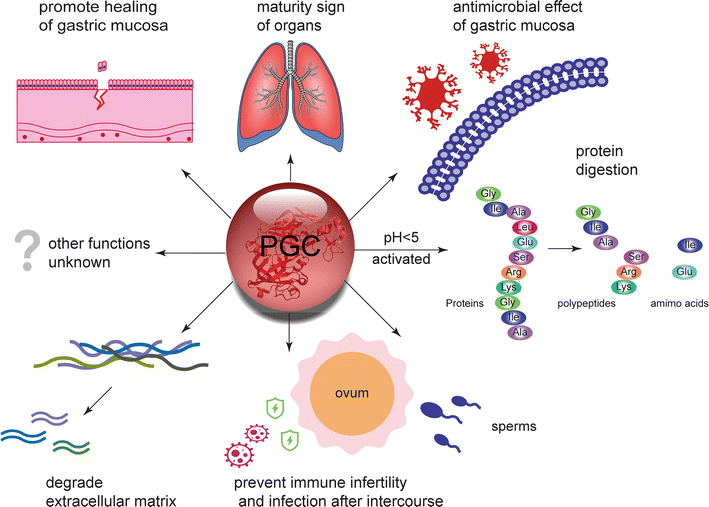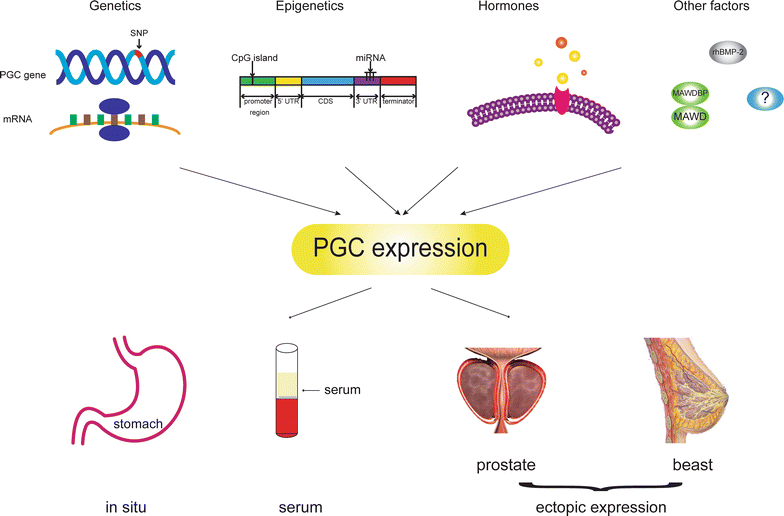Pepsinogen C expression, regulation and its relationship with cancer
- PMID: 28546787
- PMCID: PMC5442862
- DOI: 10.1186/s12935-017-0426-6
Pepsinogen C expression, regulation and its relationship with cancer
Abstract
Pepsinogen C (PGC) belongs to the aspartic protease family and is secreted by gastric chief cells. PGC could be activated to pepsin C and digests polypeptides and amino acids, but as a zymogen PGC's functions is unclear. In normal physiological conditions, PGC is initially detected in the late embryonic stage and is mainly expressed in gastric mucosa. The in situ expression of PGC in gastric mucosa is decreased considerably in the process of superficial gastritis → atrophic gastritis → gastric cancer (GC), proving that PGC is a comparatively ideal negative marker of GC. Serum PGC, and PGA levels and the PGA/PGC ratio have satisfactory sensitivity, specificity and price-quality ratio for predicting high GC risk. Ectopic PGC expression is significantly increased in prostate cancer, breast cancer, ovary cancer and endometrial cancer. In those sex-related cancers high level PGC expression indicates better prognosis and longer survival. The regulation of PGC expression involves genetic and epigenetic alteration of the encoding PGC gene, hormones modulation and interactions between PGC with other transcription factors and protein kinases. More and more research evidence hinted that PGC has strong correlation with cancer. In the systematic review, we respectively elaborate the structure, potential physiological functions, expression characteristics and regulation of PGC, and especially focus on the relationship between PGC expression and cancer to highlight the role of PGC in the tumorigenesis and its application value in clinical practice.
Keywords: Expression; Gastric cancer; Pepsinogen C; Regulation; Sex hormone.
Figures



Similar articles
-
The panoramic picture of pepsinogen gene family with pan-cancer.Cancer Med. 2020 Dec;9(23):9064-9080. doi: 10.1002/cam4.3489. Epub 2020 Oct 17. Cancer Med. 2020. PMID: 33067881 Free PMC article.
-
Pepsinogens: physiology, pharmacology pathophysiology and exercise.Pharmacol Res. 2000 Mar;41(3):265-81. doi: 10.1006/phrs.1999.0586. Pharmacol Res. 2000. PMID: 10675278 Review.
-
Expression of serum miR-20a-5p, let-7a, and miR-320a and their correlations with pepsinogen in atrophic gastritis and gastric cancer: a case-control study.BMC Clin Pathol. 2013 Mar 22;13:11. doi: 10.1186/1472-6890-13-11. BMC Clin Pathol. 2013. PMID: 23521833 Free PMC article.
-
Correlation between negative expression of pepsinogen C and a series of phenotypic markers of gastric cancer in different gastric diseases.Cancer Med. 2018 Aug;7(8):4068-4076. doi: 10.1002/cam4.1615. Epub 2018 Jul 2. Cancer Med. 2018. PMID: 29963765 Free PMC article.
-
Gene structures of pepsinogens A and C.Scand J Clin Lab Invest Suppl. 1992;210:97-110. Scand J Clin Lab Invest Suppl. 1992. PMID: 1455184 Review.
Cited by
-
The relationship between pepsinogen C and gastric carcinogenesis: a transgene and population study.BMC Cancer. 2023 Jun 8;23(1):520. doi: 10.1186/s12885-023-11020-z. BMC Cancer. 2023. PMID: 37291517 Free PMC article.
-
Mouse models of Kras activation in gastric cancer.Exp Mol Med. 2022 Nov;54(11):1793-1798. doi: 10.1038/s12276-022-00882-1. Epub 2022 Nov 11. Exp Mol Med. 2022. PMID: 36369466 Free PMC article. Review.
-
MI_DenseNetCAM: A Novel Pan-Cancer Classification and Prediction Method Based on Mutual Information and Deep Learning Model.Front Genet. 2021 Jun 3;12:670232. doi: 10.3389/fgene.2021.670232. eCollection 2021. Front Genet. 2021. PMID: 34149811 Free PMC article.
-
The panoramic picture of pepsinogen gene family with pan-cancer.Cancer Med. 2020 Dec;9(23):9064-9080. doi: 10.1002/cam4.3489. Epub 2020 Oct 17. Cancer Med. 2020. PMID: 33067881 Free PMC article.
-
Identify gene expression pattern change at transcriptional and post-transcriptional levels.Transcription. 2019 Jun;10(3):137-146. doi: 10.1080/21541264.2019.1575159. Epub 2019 Feb 5. Transcription. 2019. PMID: 30696368 Free PMC article.
References
Publication types
LinkOut - more resources
Full Text Sources
Other Literature Sources
Miscellaneous

